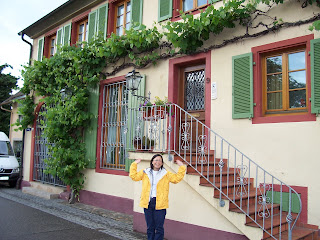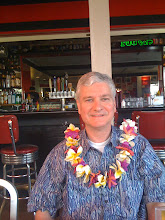The pictures ENLARGE if you click on them.
 Me with the Neuschwanstein Castle castle in the background.
Me with the Neuschwanstein Castle castle in the background. Catherine and I took a day trip from Munich to visit the Neuschwanstein castle. Below is a little background on King Ludwig that built the castle.
"Mad King" Ludwig Friedrich Wilhelm II, King of Bavaria was king of
Bavaria from 1864 until shortly before his death 1886. Ludwig's sanity or lack thereof, was a hotly disputed issue near the end of his life.
Ludwig ascended to the Bavarian throne at 18, following his father's early death.
Due to the loss of Bavarian independence, Ludwig became increasingly withdrawn from the royal court and government. In the 1880s, Ludwig spent much of his time in seclusion in the
Bavarian Alps. There he built several expensive fairytale castles including
Neuschwanstein Castle.
Mystery surrounds Ludwig's death on
Lake Starnberg. Some people believe that Ludwig was murdered by his political enemies while attempting to escape from Berg.
Ludwig asked to take a walk with Professor Gudden. The two men never returned. King Ludwig and Professor Gudden were found dead floating in the water near the
shore of Lake Starnberg.
Ludwig's death was officially ruled a suicide by drowning but there have always been doubts about the circumstances of his death. Ludwig was known to be a strong swimmer, the water was less than waist-deep where his body was found, and the official autopsy report indicated that no water was found in his lungs.
 Catherine with the Neuschwanstein
Catherine with the Neuschwanstein Castle.

The yellow Hohenschwangau Castle stands below Neuschwanstein Castle. It was "Mad" King Ludwig's boyhood home. Hohenschwangau was originally built in the 1100's. It was later ruined by Napoleon. Ludwig's father, King Maximilian II then later acquired the castle when he was crown prince and had it rebuilt in the romantic, neo-Gothic style.
 Neuschwanstein
Neuschwanstein Castle

The Grswang valley.
 Linderhof Castle
Linderhof Castle, located in the Grswang valley, was built in the style of the time of King Louis XIV of
France. It is the only one of Ludwig's three castles that was ever completed. His father, King Maximillian II, had earlier built a hunting lodge in the vicinity.

Inside
Linderhof Castle.
Ludwig Friedrich Wilhelm II, King of Bavaria - His bed in
Linderhof Castle.


Chandelier in
Linderhof Castle.

Chandelier in
Linderhof Castle.
The pictures ENLARGE if you click on them.

The grounds at Chandelier in
Linderhof Castle.

The grounds at Chandelier in
Linderhof Castle.

Fountain on the grounds at Chandelier in
Linderhof Castle.
 Linderhof Castle.
Linderhof Castle. Use the search box at the bottom of this page to find previous postings on London, Amsterdam, Japan, Germany, Austria, Yellowstone, New York, Boston, Switzerland, Alps, Plymouth Mass., Washington DC, San Francisco, Manila, San Diego or Quebec.
Labels: Bavaria, Bayern, Castle, Germany, Grswang valley, Hohenschwangau, King of Bavaria, Linderhof, Ludwig II of Bavaria, Mad King, Maximilian, Neuschwanstein, Photographs, Photos, Pictures
 The yellow Hohenschwangau Castle stands below Neuschwanstein Castle. It was "Mad" King Ludwig's boyhood home. Hohenschwangau was originally built in the 1100's. It was later ruined by Napoleon. Ludwig's father, King Maximilian II then later acquired the castle when he was crown prince and had it rebuilt in the romantic, neo-Gothic style.
The yellow Hohenschwangau Castle stands below Neuschwanstein Castle. It was "Mad" King Ludwig's boyhood home. Hohenschwangau was originally built in the 1100's. It was later ruined by Napoleon. Ludwig's father, King Maximilian II then later acquired the castle when he was crown prince and had it rebuilt in the romantic, neo-Gothic style.






































